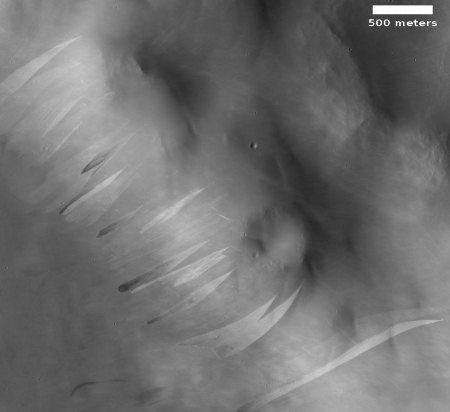Mars’ mysterious slope streaks become even more mysterious
Mars is an alien planet. This fact needs to be restated over and over, because we humans have an uncontrolled and unconscious tendency to view the things we find on Mars and assume they are caused by and resemble phenomenon we see all the time here on Earth.
Not. Mars has a very different climate, a significantly weaker gravitational field (about one third of Earth’s), and a geological and environmental make-up very alien from Earth’s. While many phenomenon there might have parallels on Earth, it is very dangerous to assume they are the same, because more often than not, they are exceedingly dissimilar and mysterious.
The image on the right is another example of this, reduced and cropped to post here. It is of some slope streaks in the Arabia Terra region on Mars, the largest most extensive region in the transition zone between the northern lowland plains and the southern highlands. I found it in my review of the August 30th release of new images from the high resolution camera on Mars Reconnaissance Orbiter.
As I already noted in my previous article about the mysterious slope streaks of Mars:
The bottom line, as noted in one paper, “The processes that form slope streaks remain obscure. No proposed mechanism readily accounts for all of their observed characteristics and peculiarities.”
Mars is strange. Mars is alien. Mars epitomizes the universe in all its glory.
The image above only reinforces this conclusion.
It shows streaks that are not even the same as the streaks I described in that previous post. The majority of slope streaks are wholly dark, and brighten with age, slowly melting into the background. These streaks however are either distinctly bright, standing out from the background, or transition from light to dark from the top to the bottom. As explained to me by Adomas Valantinas of the University of Bern in Switzerland and a member of the Trace Gas Orbiter (TGO) science team that is studying these bright slope streaks using that spacecraft’s high resolution camera,
Bright slope streaks are very common in Arabia Terra but not on other locations on Mars. …Transitioning streaks, on the other hand, are very uncommon. Only a few locations are currently known.
Valantinas directed me to two previous MRO images of bright streaks, here and here, and one image of a transitioning streak here.
The image above is in a region where relatively view close-up high resolution images have been taken, though these streaks were first imaged in a lower resolution 2007 photograph, taken by MRO’s context camera, designed to map the entire surface in lower resolution to provide the overall context for later high resolution images. The photograph to the right, cropped to post here, is from 2007 image, and shows the same slope streaks as the image above. In fact, it was this early image that inspired Valantinas to request the new high resolution image above.
Comparing the two images it appears that little has changed in the last dozen years. The bright streaks are still bright, the dark streaks are still dark, and the streaks that seem to transition from light to dark still transition in much the same way.
At the moment there are a number of theories for the creation of dark streaks, none of which can fully account for these bright and transitioning streaks. When I asked Misha Kreslavsky of the University of California in Santa Cruz, who I interviewed for my previous post on slope streaks, what he thought of these bright streaks, he was somewhat puzzled.
Not only the streaks, all types of usually dark markings are bright in this unusual location….These bright streaks confirm the idea that darkness of the streaks is due to minor disturbances of the surface. Not wetness, not salts, just disturbance. Usually it makes the surface darker, but in this unusual place it makes it brighter. I don’t know, why.
One theory for explaining at least the transitioning streaks might be that the particles might be different at the top and bottom of the streak. As Valantinas explained, “Particles at the top of the streak may be finer, ergo reflecting more light in comparison to the particles at the base of the streak.” Another theory they are considering is that the viewing angle might explain the difference in brightness. “Certain surfaces (like snow avalanches on Earth) may exhibit varying surface contrast when viewed from different angles.”
Think about how the glitter of tiny crystals in mica rock will shift and change as you shift your angle of view. These theories are a variation of this. Valantinas further explained that they are testing these theories using the camera on TGO.
This is where [TGO’s camera] shines because we can have multiple observations of the same location at different lighting conditions (due to TGO’s special orbit). MRO…on the other hand is in Sun-synchronous orbit and can only observe at the same local solar time at any given point on the Martian surface.
Given enough images taken from different angles and lighting conditions, they might be able to prove or disprove the above theories.
The theories however are still an analogue of phenomenon on Earth, and as I noted at the start of this post, it is dangerous to make such an analogy, at least not without understanding the danger.
In general, these bright and transition streaks only raise more questions: Why are these bright streaks common in Arabia Terra but not elsewhere on Mars? Why are transitioning streaks so rare? Can the existence of bright and transitioning streaks be fitted within the theories that have already been proposed for dark slope streaks? And if not, why? Are we looking at different phenomenon that only look similar?
Or to put it more bluntly, these streaks, which so much resemble at first glance avalanches on Earth, cannot possible be the same thing. They show an event flowing down a slope, but the mechanism, material, and nature of that flow remains a complete mystery.
As I said before, Mars is strange. Mars is alien. Mars epitomizes the universe in all its glory.
On Christmas Eve 1968 three Americans became the first humans to visit another world. What they did to celebrate was unexpected and profound, and will be remembered throughout all human history. Genesis: the Story of Apollo 8, Robert Zimmerman's classic history of humanity's first journey to another world, tells that story, and it is now available as both an ebook and an audiobook, both with a foreword by Valerie Anders and a new introduction by Robert Zimmerman.
The print edition can be purchased at Amazon or from any other book seller. If you want an autographed copy the price is $60 for the hardback and $45 for the paperback, plus $8 shipping for each. Go here for purchasing details. The ebook is available everywhere for $5.99 (before discount) at amazon, or direct from my ebook publisher, ebookit. If you buy it from ebookit you don't support the big tech companies and the author gets a bigger cut much sooner.
The audiobook is also available at all these vendors, and is also free with a 30-day trial membership to Audible.
"Not simply about one mission, [Genesis] is also the history of America's quest for the moon... Zimmerman has done a masterful job of tying disparate events together into a solid account of one of America's greatest human triumphs."--San Antonio Express-News



